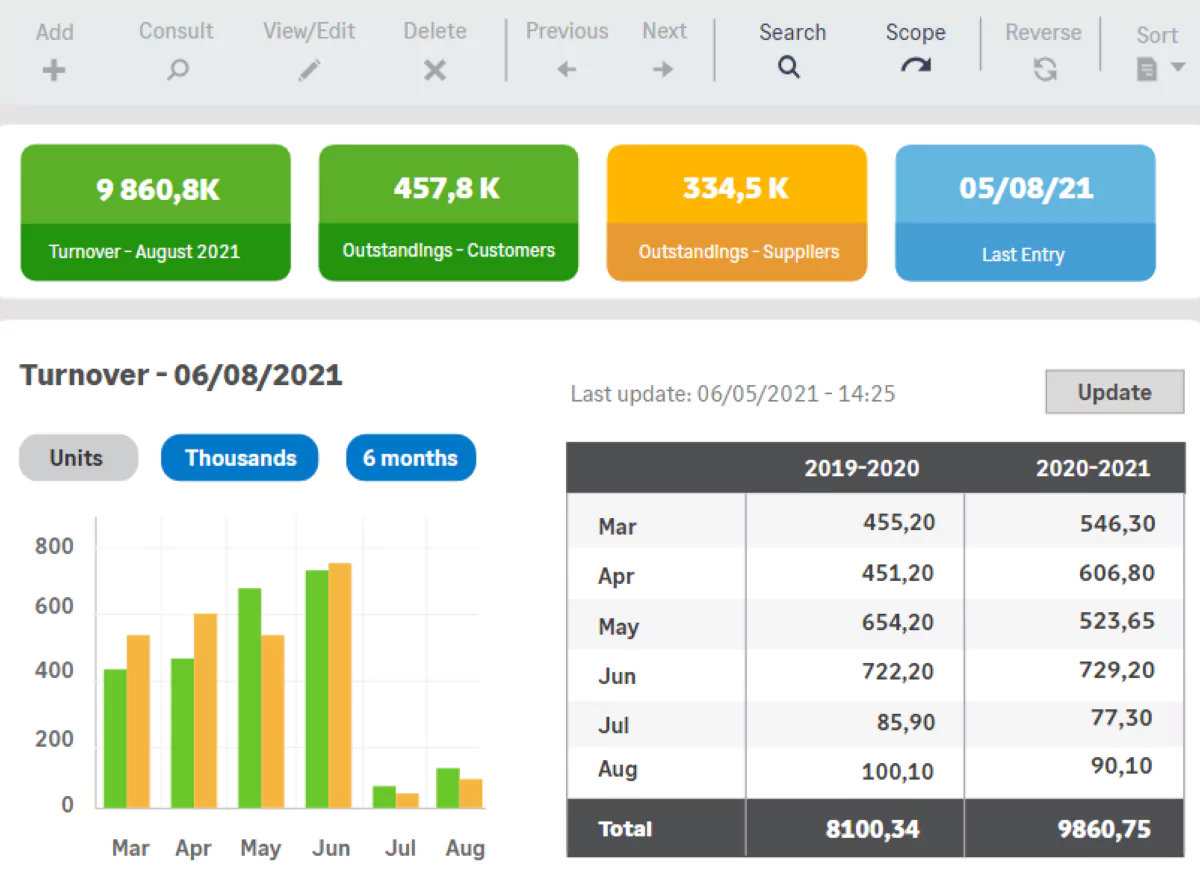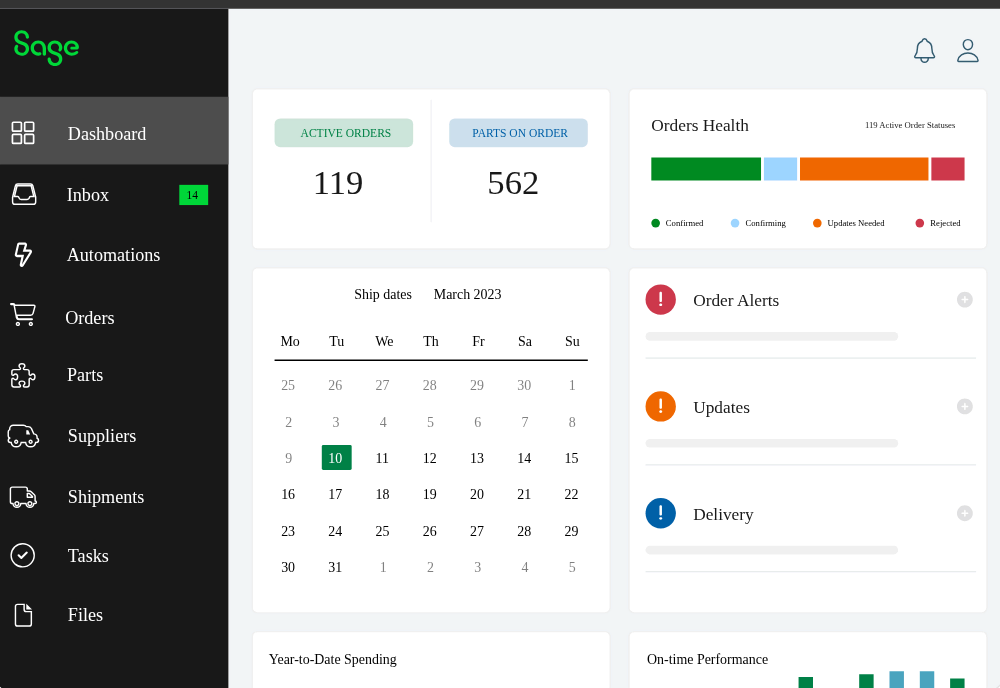Sage 100 pricing guide

When considering Sage 100, understanding the pricing structure is crucial for making an informed decision. This guide provides a detailed breakdown of Sage 100’s pricing model, including subscription bundles, deployment options, and additional costs. We’ll also explore the differences between on-premises and cloud-hosted deployments. Further, we’ll highlight key factors that impact total cost of ownership (TCO) and share tips for optimizing your investment. Whether you’re new to Sage 100 or considering an upgrade, this guide will help you make the best choice.
What is Sage 100?
Sage 100 is an ERP solution designed for small and mid-sized businesses, and is particularly well suited to manufacturing and distribution. It offers accounting, order processing, inventory control, light manufacturing, and reporting in a system that can be deployed on-premises or in the cloud through a hosting provider. With decades of development, Sage 100 is valued for its depth of functionality and adaptability across industries that require both financial management and operational oversight. Capabilities include:
- Core financial management: Sage 100 provides a comprehensive suite of accounting and finance modules. These include General Ledger, Accounts Payable, and Accounts Receivable. Features like automated bank reconciliation, electronic invoicing, and credit card processing simplify financial operations and improve accuracy.
- Advanced inventory management: Sage 100 offers multi-warehouse tracking, lot and serial number management, and automated reorder points. These features help businesses optimize stock levels, prevent shortages, and minimize carrying costs, ensuring efficient inventory control.
- Manufacturing and distribution management: Offers specialized modules like Production Management, Material Requirements Planning (MRP), and Bills of Materials (BOMs). These tools enable manufacturers to track jobs, estimate lead times, and control production costs, ensuring smooth operations.
- Flexible customization and integration: Adapts to unique business workflows with codeless customization tools like Custom Office. Additionally, tools like Visual Integrator allow seamless connectivity with other applications. These add ons and integrations include ecommerce platforms and document management systems. Sage also offers a variety of bundles and add-ons to meet unique needs.
- Powerful business intelligence and reporting: Provides advanced analytics tools, including Business Insights Explorer and customizable dashboards. Additionally, Sage Intelligence Reporting integrates with Microsoft Excel. This provides users with familiar and powerful reporting capabilities to make informed decisions.
- Multi-company support: Supports multi-company consolidations, enabling businesses to manage multiple entities or business units from a single system. This feature simplifies financial reporting and streamlines operations across different companies.
- Deployment flexibility: Businesses choose between on-premises or cloud-hosted solutions. Sage 100 can be deployed on a cloud platform for scalability and future growth, or installed on premise or on your own servers for maximum control. This scalability ensures the software can adapt to changing needs, support remote access, and grow without disruption.
- Scalability: Modular design allows expansion as business needs change, making Sage 100 ideal for growing businesses that need advanced financial management.
- Customer management: Helps manage customer transactions, enhances customer management, and maintains accurate customer history records, supporting both retail and B2B customers.
- E-commerce support: Supports e-commerce businesses through integrations and specialized modules. This enables seamless online sales and digital channel management.


See Sage 100 in action
Schedule a personalized Sage 100 demo today to experience the platform in action. See how it’s expertly tailored to meet the unique needs of your business and discover the difference it can make to your organization.
How is Sage 100 licensed and priced?
To understand the cost of Sage 100 you need to look beyond the base software. Licensing and pricing are influenced by several factors, including the number and type of users you need, the software bundle selected, any industry-specific modules required, and optional third-party add-ons. Each of these components contributes to the overall investment, making it important to evaluate your business needs before purchasing. Below, we’ll break down each element that impacts Sage 100 licensing and pricing.
User licenses
Sage 100 licensing is based on the number of users who need access to the system. Costs vary depending on whether you require full access for accounting and operational staff or limited access for employees who only need specific functions. Carefully assessing user roles can help optimize costs while ensuring team members have the tools they need.
Bundles (Essentials, Advanced, Complete)
Sage 100 is structured into tiered bundles of varying functionalities. They dramatically influence licensing cost. Essentials is the most affordable, while Complete offers the broadest coverage for a higher price. A very rough estimate of starting price is $76 per month, per user.
Essentials: Includes core modules like General Ledger, Accounts Payable, Accounts Receivable, Bank Reconciliation, Business Insights, Custom Office, Credit Card Processing, Visual Integrator, Sage Intelligence, and Crystal Reports.
Advanced and Complete: These bundles build on Essentials by adding modules such as Purchase Order, Sales Order, Inventory Management, Mobility for Barcode, Bill of Materials, and Job Cost.
Distribution and manufacturing modules
Beyond bundled options, industry-targeted modules allow more tailored functionality. These are especially important for businesses in manufacturing or distribution. They include: Bill of Materials, Production Management, Inventory Requirements Planning (IRP), Return Merchandise Authorization (RMA), and Mobility for Barcode
Third-party add ons
Sage 100 supports integration with a wide ecosystem of third-party tools, particularly helpful for workflows like payroll, e-commerce, advanced reporting, and HR. Available via the Sage Marketplace, add-ons include business intelligence, planning, compliance, and advanced reporting. Because they are purchased separately, they can add from a few hundred to several thousand dollars, depending on complexity and vendor.
Deployment options: On-premises vs. cloud hosting
Sage 100 can be installed on your own servers for on-premise deployment. Or it can be deployed on a cloud platform for easier scaling and future growth. Both approaches offer advantages, but costs and TCO considerations differ.
On-premises: An on-premises Sage 100 deployment gives businesses full control over their hardware, data, and upgrade schedule. While it requires investment in servers, storage, and IT support, some companies prefer on-premises for customization and tighter control. This option may have higher long-term costs compared to cloud hosting but can be the right fit for organizations with established IT infrastructure and complex compliance requirements.
Cloud hosting: Choosing cloud hosting for Sage 100 can reduce infrastructure costs, simplify IT management, and improve security. Existing Sage 100 customers may also qualify for discounts on their next upgrade by moving to the cloud. Beyond cost savings, hosting positions your business for a smoother transition to a modern, true cloud solution like Sage Intacct when the time is right.

The ultimate Sage 100 implementation guide
Don’t let costly mistakes and delays disrupt your Sage 100 implementation. Discover tips to simplify your implementation, reduce risks, and maximize ROI. Get the insights you need for a smooth implementation.
Implementation costs
Sage Partners configure the system, migrate data, and train staff. Costs vary depending on company size, complexity, and deployment model. On-premises implementations may also require investment in servers or infrastructure, while hosted options usually roll infrastructure costs into the subscription. Cost considerations:
- Number of users: The more users you need to support, the higher the subscription cost and the greater the implementation effort for training and setup.
- Modules and add-ons: Selecting additional modules (like CRM or inventory) or third-party integrations will increase the cost.
- Customization: Extensive customization of the software to fit your unique business processes adds significantly to the implementation cost.
- Data migration: Moving data from your old system to Sage 100 requires time and effort, which impacts the overall cost.
Sage 100 total cost of ownership (TCO)
When evaluating Sage 100, it’s important to look beyond subscription or licensing costs to understand the true total cost of ownership (TCO). Consider implementation, customization, training, and ongoing support, as well as IT infrastructure if hosting on-premises. Factor in future upgrades, integrations, and potential add-on modules to ensure you have a clear picture of long-term investment requirements. Costs include:
- System maintenance: Sage 100 releases annual upgrades. Installing these may involve IT resources and temporary downtime.
- Infrastructure costs: Includes expenses for on-site servers and data storage.
- Licensing and backup software: Windows server licenses and disaster recovery tools are needed for security and data protection.
- IT services and support: Can be handled by internal staff or outsourced providers for ongoing maintenance and troubleshooting.
- Downtime considerations: Hardware issues, software updates, and security patches may occasionally affect system availability.

How to purchase Sage 100
Sage 100 is distributed exclusively through Sage Partners. They handle quoting, implementation, and support. They can also help businesses choose between on-premises or private hosting. Working with an experienced Sage Partner like MicroAccounting ensures access to bundled pricing, financing options, and industry-specific best practices. Sage Partners can discuss your requirements and provide personalized pricing.
Licensing tips and best practices for Sage 100
Evaluate user access models
Sage 100 offers different user access models, such as concurrent users (shared licenses for users who log in at different times) and named users (dedicated licenses for specific individuals). Carefully evaluate your team’s usage patterns to determine which model is more cost-effective. For example, concurrent licenses may be ideal for teams with staggered usage, while named licenses are better for employees who need constant access.
Choose bundles wisely
Sage 100 offers different subscription bundles: Essentials, Advanced, and Complete. Start with the Essentials package to cover your core needs, and scale into Advanced or Complete as your business grows or requires additional functionality. This approach helps you avoid overpaying for features you may not need initially while ensuring you can expand capabilities when necessary.
Plan for long-term support
Select a support plan that aligns with your internal IT capacity and business requirements. If your organization has a robust IT team, a basic support plan may suffice. However, if you lack in-house IT resources, consider premium support options that provide faster response times, dedicated account managers, and proactive system monitoring. Investing in the right support plan ensures smooth operations and minimizes downtime.
Leverage Sage Partner expertise
Sage Partners like MicroAccounting bring deep expertise in configuring Sage 100 for specific industries, such as manufacturing and distribution. They can help tailor the system to your unique workflows, integrate third-party tools, and provide training for your team. Partnering with a knowledgeable VAR ensures a smoother implementation process and maximizes the value of your Sage 100 investment.
By following these licensing tips and best practices, businesses can effectively manage costs, optimize system performance, and ensure their Sage 100 deployment supports both current and future needs. Strategic planning and leveraging expert guidance can make all the difference in achieving a successful implementation. Choosing the right solution for your unique needs is essential to maximize the value of your accounting software investment.

Get Sage 100 today
Take the next step with Sage 100 today. Let MicroAccounting help you choose the perfect solution and tailor the platform to fit your unique business needs. Start building a scalable, value-driven solution for your success.
Sage 100 pricing FAQs
How is Sage 100 licensed and priced?
By user subscription, based on bundle selection, industry-specific modules, and third-party add-ons.
What are the deployment options?
Sage 100 can be installed on your own servers or deployed on a cloud platform via a hosting provider.
What are the implementation costs?
Depends on company size, number of users, modules, customization, data migration, and deployment model.
Where can I get current pricing information?
Contact an authorized Sage Partner for the most current pricing information tailored to your needs.
How do I purchase Sage 100?
Through authorized Sage Partners, who manage quoting, implementation, and ongoing support.
Next steps
Understanding Sage 100’s pricing structure and the factors that influence cost is essential for making a well-informed investment. Elements like license types, subscription terms, implementation services, and total cost of ownership (TCO) all play a critical role in shaping your budget and ensuring the success of your ERP deployment. With strategic planning and the right partner, you can achieve a smooth, efficient, and cost-effective implementation that supports your business goals.
At MicroAccounting, we specialize in empowering small and mid-sized businesses with expert Sage 100 implementation, training, support, and system optimization. Whether you’re just beginning to explore your options or are ready to move forward, our team of experienced professionals is here to guide you every step of the way. Contact us today to connect with a Sage 100 expert.


